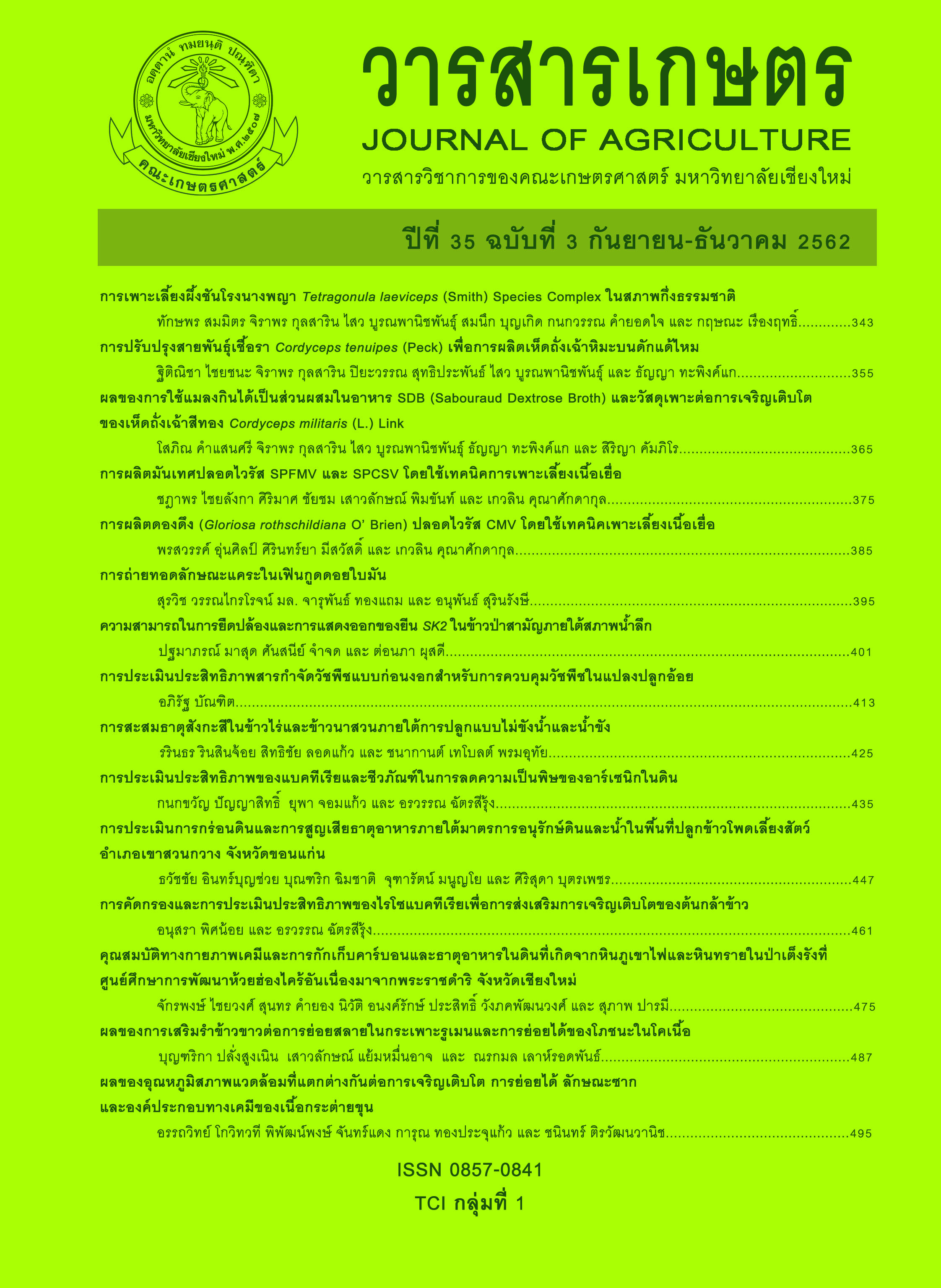ผลของการเสริมรำข้าวขาวต่อการย่อยสลายในกระเพาะรูเมนและการย่อยได้ของโภชนะในโคเนื้อ
Main Article Content
บทคัดย่อ
วัตถุประสงค์ของการศึกษาในครั้งนี้เพื่อวิเคราะห์องค์ประกอบทางเคมี ค่าการย่อยสลายในกระเพาะหมักและความสามารถการย่อยได้ของโภชนะในตัวสัตว์ของอาหารข้นที่เสริมรำข้าวขาวในระดับที่แตกต่างกัน โดยทำการประกอบสูตรอาหารข้นที่มีการเสริมรำข้าวขาวต่างระดับได้แก่ T1 (0%) T2 (10%) T3 (20%) และ T4 (30%) วิเคราะห์องค์ประกอบทางเคมีโดยวิธี proximate analysis ทำการวิเคราะห์การย่อยสลายในกระเพาะรูเมนโดยวิธี nylon bag technique และความสามารถในการย่อยได้ในโคเนื้อพื้นเมืองเพศผู้เจาะกระเพาะจำนวน 4 ตัว ทำการศึกษาการย่อยสลายในกระเพาะรูเมนโดยบ่มตัวอย่างอาหารเป็นเวลา 2, 4, 8, 12, 24, 48, 72 และ 96 ชั่วโมง สำหรับการศึกษาความสามารถในการย่อยได้ในตัวสัตว์ ใช้โคเจาะกระเพาะ เพศผู้ตอน จำนวน 4 ตัว วางแผนการทดลองแบบ 4x4 Latin square ทำการเก็บอาหารที่ให้ อาหารที่เหลือและมูล จากการศึกษาองค์ประกอบทางเคมีพบว่าค่า DM และ OM ของสูตรที่เสริมรำข้าวขาว ลดลงตามระดับของรำข้าวขาวที่เพิ่มสูงขึ้น (P<0.05) ค่า EE ของ T3 และ T4 มีค่ามากที่สุดอย่างมีนัยสำคัญทางสถิติ (P<0.05) พบว่าค่าการย่อยสลายในกระเพาะรูเมนไม่แตกต่างกันทางสถิติ แต่ส่วนที่ละลายได้ (washing loss) ของอาหารข้นที่เสริมรำข้าวขาว 0% มีค่าสูงกว่าระดับอื่น ๆ (P<0.05) นอกจากนี้ความสามารถในการย่อยได้ของเยื่อใยมีความแตกต่างแบบ quadratic (P<0.05) และความสามารถในการย่อยได้ของเยื่อใย NDF และเยื่อใย ADF พบว่า อาหารข้นที่เสริมรำข้าว 10% มีค่ามากกว่าระดับการเสริมอื่น ๆ (P<0.05) จากการศึกษาในครั้งนี้สรุปได้ว่าอาหารข้นที่เสริมรำข้าวขาว 10% เหมาะสมในการเสริมสำหรับโคเนื้อ
Article Details
เอกสารอ้างอิง
AOAC. 2000. Official Methods of Analysis of AOAC International. 17th ed. AOAC International, Gaithersburg, Maryland.
Bhatt, R.S., S.R. Sharma, U. Singh, D. Kumar and K.S. Risam. 2005. Effect of substituting groundnut cake with different levels of rice bran on growth and wool production of German Angora rabbits. World Rabbit Science 13(3): 179-187.
Cheva-isarakul, B. 2003. Biochemistry in Animal Science. Department of Animal Science, Faculty of Agriculture, Chiang Mai University, Chiang Mai. (In Thai)
Cone, J.W., A.H. Van Gelder and F. Dreihuis. 1997. Description of gas production profiles with a three-phasic model. Animal Feed Science and Technology 66: 31-45.
Moonmat, N., M. Otsuka, S. Udchachon and K. Sommart. 2010. Nutritive value and metabolizable energy evaluation of rice bran, kapok seed meal and coconut meal in Thai native beef cattle. Journal of Science and Technology Mahasarakham University 29(4): 382-388. (In Thai)
NRC. 2001. Nutrient Requirements of Dairy Cattle. 7th ed. National Academy Press, Washington, D.C.
Ørskov, E.R. and I. McDonald. 1970. The estimation of protein degradability in the rumen from incubation measurements weighted according to rate of passage. Journal Animal Science 92(2): 499-503.
Schneider, B.H. and W.P. Flatt. 1975. The Evaluation of Feeds Through Digestibility Experiments. University of Georgia Press, Georia, U.S.A.
Soren, N.M., R. Bhar, A.K. Chhabra and A.B. Mandal. 2004. Utilization of energy and protein in local Indian crossbred gilts fed diets containing different levels of rice bran. Asian-Australasian Journal of Animal Sciences 17(5): 688-692.
Steel, R.G.D. and J.H. Torrie. 1980. Principles and Procedures of Statistics: A Biometrical Approach. 2nd ed. McGraw-Hill, New York. 672 p.
Van Soest, P.J., J.B. Robertson and B.A. Lewis. 1991. Methods for dietary fiber, neutral detergent fiber, and nonstarch polysaccharides in relation to animal nutrition. Journal of Dairy Science 74: 3583-3597.
Wachirapakorn, C., C. Wongnen, A. Cherdthong and K. Phonsaen. 2016. Effects of dried ethanol by-product in total mixed ration on intake, digestibility, yield and milk composition of lactating cows. Journal of Agriculture 32(2): 247-259. (In Thai)
Yulistiani, D., Z.A. Jelan and J.B. Liang. 2008. Degradability of mulberry (Morus alba) and rice bran in the rumen of sheep fed different diets. Indonesian Journal of Animal and Veterinary Sciences 13(4): 264-272.


